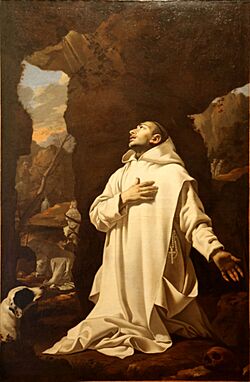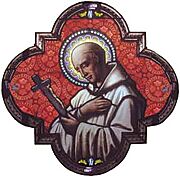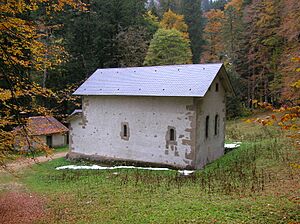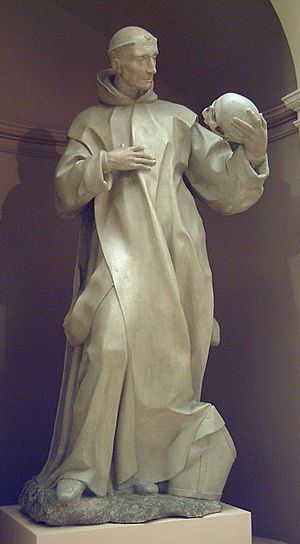Bruno of Cologne facts for kids
Quick facts for kids SaintBruno of Cologne OCart |
|
|---|---|

Saint Bruno of Cologne, by Nicolas Mignard
|
|
| Monk, hermit | |
| Born | c. 1030 Cologne, Archdiocese of Cologne |
| Died | 6 October 1101 Serra San Bruno |
| Venerated in | Roman Catholic Church |
| Beatified | 1514 by Pope Leo X |
| Canonized | 17 February 1623 by Pope Gregory XV |
| Feast | 6 October |
| Attributes | Carthusian habit, holding a skull, rule of the Carthusian order, crucifix |
Bruno of Cologne (German: Bruno von Köln; Italian: Bruno di Colonia; c. 1030 – 6 October 1101) is known as Saint Bruno. He was the person who started the Carthusian Order, a group of monks. He set up the first two communities for this order. Bruno was a very respected teacher in Reims, France. He was also a close helper and friend to Pope Urban II, who used to be his student. Saint Bruno's special day is 6 October.
Contents
Bruno's Early Life and Education
Bruno was born in Cologne, Germany, around the year 1030. Not much is known about his very early life. We do know that he studied theology in Reims, which is now in France.
After finishing his studies, Bruno went back to Cologne. He became a priest there around 1055. In 1056, he was called back to Reims by Bishop Gervais. The next year, Bruno became the head of the important school there. This meant he was in charge of all the schools in the area.
For 18 years, from 1057 to 1075, Bruno helped the school in Reims keep its excellent reputation. He was known as a great thinker and a wise teacher. Many important people were his students. One of them was Eudes of Châtillon, who later became Pope Urban II.
Working for the Church
In 1075, Bruno became the chancellor of the Archdiocese of Reims. This job meant he helped manage the daily tasks of the church area. At that time, the bishop, Manasses de Gournai, was not a good leader. He was violent and not truly interested in his church duties.
Bruno and other church leaders tried to get rid of Manasses. In 1077, Manasses was temporarily removed from his position. He reacted badly, destroying homes and taking things from those who spoke against him. Bruno quietly stayed away from the main church city. Finally, in 1080, Manasses was forced to leave.
Starting a New Life as a Hermit

Bruno was offered the chance to become a bishop himself. But he had made a promise to leave worldly things behind. So, he decided to become a hermit, someone who lives alone for religious reasons. He left Reims with two friends, Raoul and Fulcius.
At first, Bruno thought about joining another group of hermits. But he soon realized that was not the right path for him. In 1084, he and six companions went to Bishop Hugh of Grenoble. The bishop helped them find a quiet, mountainous place in the Dauphiné region of France. This place was called Grande Chartreuse.
There, Bruno and his companions built a small church. They also built small, separate huts where each person could live alone. They lived simply, focusing on prayer and study. They were known for their wisdom and learning. Bishop Hugh of Grenoble often visited them and became like one of them.
Called to Rome by the Pope
In 1088, Bruno's former student, Eudes of Châtillon, became Pope Urban II. The Pope needed wise and loyal helpers. He called Bruno to Rome in 1090.
Bruno worked as a secret advisor to the Pope. He stayed out of the public eye and avoided the political fights in Rome. Soon after he arrived, the Pope and his supporters had to leave Rome because of Emperor Henry IV.
Bruno was offered the important job of Archbishop of Reggio Calabria. But he said no. Instead, he suggested one of his former students for the role. Bruno really wanted to go back to his quiet life as a hermit. He hoped to rejoin his friends in France. However, Pope Urban II wanted him to stay in Italy, close by if he was needed.
Bruno did not go to the famous Council of Clermont, where the First Crusade was announced. He was likely at another meeting, the Council of Benevento, in 1091. His work during this time was mostly behind the scenes.
Founding a New Community in Italy
In 1091, Bruno and some new followers found a new quiet place in Italy. It was a small, forested valley in the Diocese of Squillace. They built a small wooden chapel and simple cabins there. Roger I of Sicily, a powerful count, became their supporter. He gave them the land they used.
Bruno and Count Roger became good friends. Bruno visited the count when he was sick. He also baptized the count's son, Roger II of Sicily, who would later become King of Sicily. Count Roger often visited Bruno's quiet retreat. In 1095, a monastery called St. Stephen was built there, thanks to Roger's help.
Around the year 1100, many of Bruno's friends passed away. Pope Urban II died in 1099. Landuin, one of his first companions, died in 1100. Count Roger died in 1101. Bruno himself passed away on 6 October 1101, in Serra San Bruno.
Bruno's Lasting Impact
After Bruno died, the Carthusian monks in Italy sent out a special messenger. This messenger carried a long scroll of parchment. He traveled through Italy, France, Germany, and England. At each church or community, he announced Bruno's death. In return, people wrote messages of sadness and promises of prayers on the scroll.
Many of these scrolls still exist today. They show how much people admired Bruno. Many who knew him praised his great knowledge and teaching skills. Even strangers were impressed by his wisdom. His followers especially admired his deep prayer, simple living, and devotion to the Virgin Mary.
Both of the churches Bruno built in his quiet retreats were dedicated to the Virgin Mary. The Carthusian Order still honors her as their main protector. Bruno is also the name for San Bruno Creek in California.
Honoring Saint Bruno
Bruno was buried in the small cemetery of his hermitage. In 1513, his bones were found with a Latin message that said, "These are the bones of the master Bruno." The Carthusian Order values humility, so Saint Bruno was never formally made a saint in a big ceremony. However, in 1623, Pope Gregory XV officially added him to the list of saints celebrated on 6 October.
Saint Bruno has long been seen as a special protector of Calabria in Italy and one of the patron saints of Germany.
Bruno was not only a founder but also a writer. He wrote explanations of the Psalms and the letters of Paul the Apostle in the Bible. Two of his own letters also survive. He also wrote a short poem about not caring too much about worldly things. His writings show that he knew some Hebrew and Greek. He was also familiar with the writings of early church leaders like Augustine of Hippo. His writing style was clear and simple.
In Catholic art, you can often recognize Saint Bruno. He is usually shown holding and thinking about a skull. He might also have a book and a cross. Sometimes, he has a halo of seven stars around his head.
See also
 In Spanish: Bruno de Colonia para niños
In Spanish: Bruno de Colonia para niños
- Spatiamentum
- Cologne Charterhouse
- Chapel of Saint-Jean du Liget




